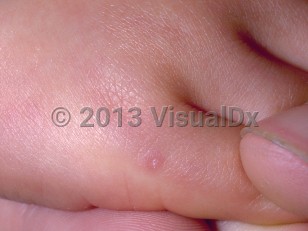Infantile myofibromatosis in Infant/Neonate
Synopsis

In the solitary form, a single papule or nodule affecting the skin, subcutaneous tissue, or muscle is present, most commonly on the trunk, head, or neck. In the multicentric form, lesions can be seen in the bone and viscera. Skeletal lesions occur in more than half of cases, with the skull, femur, tibia, spine, and ribs involved most commonly. The generalized form of the disease is characterized by visceral involvement and usually has a poor prognosis. The most common sites of visceral involvement include the heart, lung, bones, and gastrointestinal (GI) tract.
Without visceral involvement, the prognosis is favorable: it is typically benign and self-limited and has a low recurrence rate.
PDGFRB germline mutations have been associated with inflammatory myofibromatosis in some cases and may predispose to the formation of cerebral aneurysms.
Codes
Q89.8 – Other specified congenital malformations
SNOMEDCT:
254146000 – Infantile myofibromatosis
Look For
Subscription Required
Diagnostic Pearls
Subscription Required
Differential Diagnosis & Pitfalls

Subscription Required
Best Tests
Subscription Required
Management Pearls
Subscription Required
Therapy
Subscription Required
References
Subscription Required
Last Updated:07/16/2023

